Related Research Articles

Chromodorididae, or chromodorids, are a taxonomic family of colourful, sea slugs; dorid nudibranchs, marine gastropod mollusks in the superfamily Doridoidea. “Chromodorid nudibranchs are among the most gorgeously coloured of all animals.” The over 360 described species are primarily found in tropical and subtropical waters, as members of coral reef communities, specifically associated with their sponge prey. The chromodorids are the most speciose family of opisthobranchs. They range in size from <10mm to over 30 cm, although most species are approximately 15–30 mm in size.
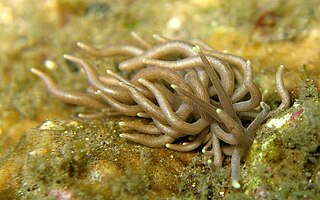
Phyllodesmium briareum is a species of sea slug, an aeolid nudibranch, a marine gastropod mollusc in the family Facelinidae.

Phyllodesmium is a genus of predatory sea slugs, aeolid nudibranchs, marine gastropod molluscs in the family Facelinidae.

Phyllodesmium longicirrum, common name the solar-powered phyllodesmium, is a species of sea slug, an aeolid nudibranch, a marine gastropod mollusc in the family Facelinidae.

Phyllodesmium crypticum is a species of sea slug, an aeolid nudibranch, a marine gastropod mollusc in the family Facelinidae.
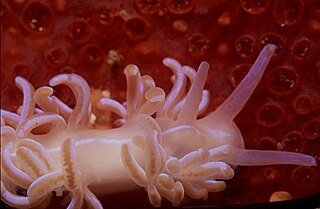
Phyllodesmium horridum, the coral nudibranch, is a species of sea slug, specifically an aeolid nudibranch. It is a marine gastropod mollusc in the family Facelinidae.

Tritoniopsis elegans is a species of dendronotid nudibranch. It is a marine gastropod mollusc in the family Tritoniidae and is found in the western Indo-Pacific. It was first described by the French naturalist Jean Victoire Audouin in 1826, the type specimen being found in the Red Sea.

Phyllodesmium rudmani is a species of sea slug, an aeolid nudibranch, a marine gastropod mollusc in the family Facelinidae.

Xeniidae is a family of soft coral in the order Alcyonacea.

Phyllodesmium colemani is a species of sea slug, an aeolid nudibranch, a marine gastropod mollusc in the family Facelinidae.
Phyllodesmium guamense is a species of sea slug, an aeolid nudibranch, a marine gastropod mollusc in the family Facelinidae.
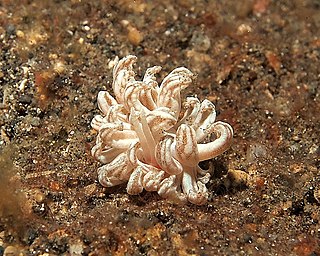
Phyllodesmium jakobsenae is a species of sea slug, an aolid nudibranch, a marine gastropod mollusk in the family Facelinidae.

Phyllodesmium magnum is a species of sea slug, an aeolid nudibranch, a marine gastropod mollusc in the family Facelinidae.

Phyllodesmium opalescens is a species of sea slug, an aeolid nudibranch, a marine gastropod mollusc in the family Facelinidae.
Phyllodesmium parangatum is a species of sea slug, an aeolid nudibranch, a marine gastropod mollusc in the family Facelinidae.
Phyllodesmium pinnatum is a species of sea slug, an aeolid nudibranch, a marine gastropod mollusc in the family Facelinidae.
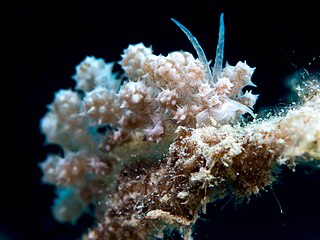
Phyllodesmium koehleri is a species of sea slug, an aeolid nudibranch, a marine gastropod mollusc in the family Facelinidae.
Phyllodesmium lembehense is a species of sea slug, an aeolid nudibranch, a marine gastropod mollusc in the family Facelinidae.

Phyllodesmium lizardense is a species of sea slug, an aeolid nudibranch, a marine gastropod mollusc in the family Facelinidae.
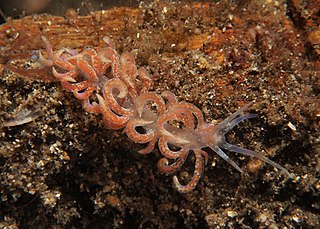
Phyllodesmium poindimiei is an Alcyonacea feeding, aeolid nudibranch Gastropod belonging to the family Facelinidae. Cerata are important in this clade in terms of their physical defense and efficient metabolic processes. This species is spread sporadically along tropical coastal regions such as Australia, Hawaii, and the Indo-Pacific living in diverse marine habitats such as coral reefs. Unlike other species in the Opisthobranch Mollusca clade, P. poindimiei’s lush pink cerata are used for defensive purposes other than Nematocyst (dinoflagellate) capture and toxin release. Organismal ties within these thriving, tropical ecosystems can be determinants of environment change, which affects massive coral ecosystems. Continuously changing marine ecosystems, such as coral reefs, are directly linked to the evolution of organisms that live and thrive in the tropics such as the soft nudibrach P. poindimiei.
References
- ↑ Ehrenberg, C. G., 1831. Symbolae physicae seu icones et descriptiones animalium evertebratorum sepositis insect is quae ex itinere per Africam Borealem et Asiam Occidentalem. Decas I Mollusca.
- 1 2 3 Bouchet, P. (2015). Phyllodesmium hyalinum. In: MolluscaBase (2015). Accessed through: World Register of Marine Species on 2015-10-06
- ↑ Rudman W.B. (1991) Further studies on the taxonomy and biology of the octocoral-feeding genus Phyllodesmium Ehrenberg, 1831 (Nudibranchia: Aeolidoidea). Journal of Molluscan Studies 57: 167-203.
- ↑ Burghardt I. & Wägele H. (2004). "A new solar powered species of the genus Phyllodesmium Ehrenberg, 1831 (Mollusca: Nudibranchia: Aeolidoidea) from Indonesia with analysis of its photosynthetic activity and notes on biology". Zootaxa 596: 1-18. PDFt.
- 1 2 Rudman, W.B., 1998 (October 15) Phyllodesmium hyalinum Ehrenbergh, 1831. [In] Sea Slug Forum. Australian Museum, Sydney.
- Richmond, M. (Ed.) (1997). A guide to the seashores of Eastern Africa and the Western Indian Ocean islands. Sida/Department for Research Cooperation, SAREC: Stockholm, Sweden. ISBN 91-630-4594-X. 448 pp